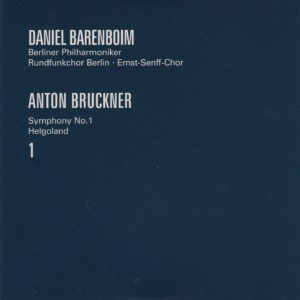
Today, while a very rare February thunderstorm drenches our fair city, I am listening to Bruckner’s Symphony No. 1 in C Minor (WAB 101), nicknamed “The Saucy Maid,” interpreted by Argentine-born pianist and conductor Daniel Barenboim (1942-), whom I saw conduct the Staatskapelle Berlin at Carnegie Hall on January 28th of this year. The symphony that magical night was Bruckner’s Eighth.
Barenboim’s orchestra for today’s performance is the Berliner Philharmoniker.
The music label is Warner Classics, which was awarded “Label of the Year” at the 2016 Gramophone Awards in London last October.
NOTE: I have two Barenboim CD box sets for this leg of my Bruckner journey. The first (which I’ll call the “Blue Box”) is on the Warner Classics label. The second (which I’ll call the “Pink Box”) is on the Deutsche Grammophon label. The performances in the Blue Box were recorded in the 1990s. The performances in the Pink Box were recorded much more recently, 2012 and 2010. So…alpha by conductor, then chronological. That’s the plan.
The composer is Austrian Anton Bruckner (1824-1896).
Bruckner’s Symphony No. 1 in C Minor is cataloged as WAB 101.
WAB stands for Werkverzeichnis Anton Bruckner. Werkverzeichnis means “catalog of works” in German.
It’s entry on Wikipedia tells us,
The WAB numbers…refer to the Werkverzeichnis Anton Bruckner. This is a thematic catalogue of the music of Anton Bruckner compiled by Renate Grasberger. Lost works, sketches, etc. were added afterwards. Some other, still unclassified, works were identified as WAB deest. The WAB uses a single range of numbers divided into subranges for genre classification. Grasberger sorted the compositions alphabetically by title within each of the subranges. For a few of the pieces, she used an alternate title which is less used today or classified them in different subranges than the current Gesamtausgabe.
 I’d forgotten how much I enjoyed Bruckner’s First. I hadn’t heard it in several months. So listening to it again this morning brought back fond memories.
I’d forgotten how much I enjoyed Bruckner’s First. I hadn’t heard it in several months. So listening to it again this morning brought back fond memories.
The way I worked it last time (144 Days With Bruckner And Me), I posted the objective information first.
Then “rated” it at the end. That seemed to work for me. So I’ll do it that way this time.
By the way, I don’t intend to reinvent the wheel here.
If you want a bio of Daniel Barnenboim, background on Symphony No. 1 in C Minor, visit their respective links above, or see my first post (Day 1) from my 144 Days project.
What I’d like to do for this leg of my Bruckner journey is find different topics to explore and write about. Something new about each symphony, conductor, or orchestra.
So, here are the objective stats:
 Bruckner’s Symphony No. 1 in C Minor (WAB 101), composed between 1865 and 1866 (Linz version)
Bruckner’s Symphony No. 1 in C Minor (WAB 101), composed between 1865 and 1866 (Linz version)
Daniel Barenboim conducts
Barenboim used the “Leopold Nowak Edition, 1953”, according to the CD sleeve
Berliner Philharmoniker plays
The symphony clocks in at 61:32
This was recorded in Berlin, Germany, in 1996
Barenboim was 54 when he conducted it
Bruckner was 42 when he finished composing it (the first time)
This recording was released on the Warner Classics label
Bruckner wrote his symphonies in four movements. The time breakdown of this one (Symphony No. 1 in C Minor), from this particular conductor (Barenboim) and this particular orchestra (Berliner Philharmoniker) is as follows:
I. Allegro (C minor)……………………………………………………………………………………12:49
II. Adagio (A-flat major)………………………………………………………………………………………………………..13:36
II. Scherzo: Lebhaft (lively)—G minor – Trio: Langsam (slowly)—G major…………………………………………………………………………………………………………..9:20
IV. Finale: Bewegt und feurig (with motion and pep)—C minor………………………………………………………………………………………………………….13:59
Total running time: 61:32
From its entry on Wikipedia:
Symphony No. 1 in C minor
Bruckner’s Symphony No. 1 in C minor, (sometimes called by Bruckner “das kecke Beserl” (roughly translated as “the saucy maid”), was completed in 1866, but the original manuscript of this symphony was not reconstructed until 1998. Instead, it is commonly known in two versions, the so-called Linz Version, which is based mainly on rhythmical revisions made in 1877, and the completely revised Vienna Version of 1891.
From its entry on Wikipedia regarding the edition (Nowak, 1953) Barenboim used I was able to piece together that Nowak based his edition on the 1877/1884 version.
About Leopold Nowak, his entry on Wikipedia tells us,
Leopold Nowak
While the Allies enforced denazification, Haas’ work was frowned upon and his rival Leopold Nowak was appointed to produce a whole new edition from scratch.
From the 1950s onwards, Nowak revised and re-issued the editions of Haas, Wöss, Oeser and Orel. He claimed that in the case of Symphonies No. 2 and No. 8, Haas had mixed and matched passages from an early version and a later version to create “hybrid” scores. However, when the manuscripts became available in microfilm, it was found that the passages that Haas had allegedly mixed in from earlier manuscripts were actually present, but crossed out in the manuscript that Haas worked with; Bruckner wrote a letter to the conductor Felix Weingartner, in which he mentioned the cut passages and hoped that they will prove “valid for posterity, and for a circle of friends and connoisseurs”.
Beside the 1876, 1877/1878 (re-issue with the Coda of the Scherzo) et 1889 versions of Symphony No. 3, Nowak issued the until that time forgotten, first version of Symphonies 3, 4 and 8.
In 1980 Günter Brosche re-issued the 1891 version of Symphony No. 1.
Okay. Now, here are the subjective aspects:
My Rating:
Recording quality: 4
Overall musicianship: 5
CD liner notes: 5 (a heavy booklet, 1/4-inch thick with lengthy essays translated into English, French, German, and what appears to be Portuguese)
How does this make me feel: 4
This was a thrill to hear again. Seriously. Bruckner’s First is a “saucy maid,” indeed, filled with flirtatiousness and verve and a sexiness all its own.
And this is a fine recording. I usually don’t like all-digital recordings (rendered “DDD” on CD covers). They can be brittle, too dry, not warm. This argument is often made by vinyl people – you know, those music aficionados who think vinyl records sound warmer and better. I grew up during the age of vinyl records. To me, it sounded like a box of Rice Krispies – snap, crackle, and pop. I heard the needle in the grooves. If that means the sound was warmer, so be it.
I prefer a nice remastered CD, to be honest. But with DDD used sparingly.
In this case, the DDD designation doesn’t appear to have made this a brittle, dry recording.
My favorite movement in Bruckner’s First is the Allegro – the opening. That opening melody stuck with me the entire time I was listening to other symphonies. It’s powerful.
And the musicians sound like they’re giving it their all, playing with palpable enthusiasm.
If the quality of this performance is any indication, I’m looking forward to hearing the rest of what’s in this box set.
I’m going to have to give this a big “Huzzah!”
